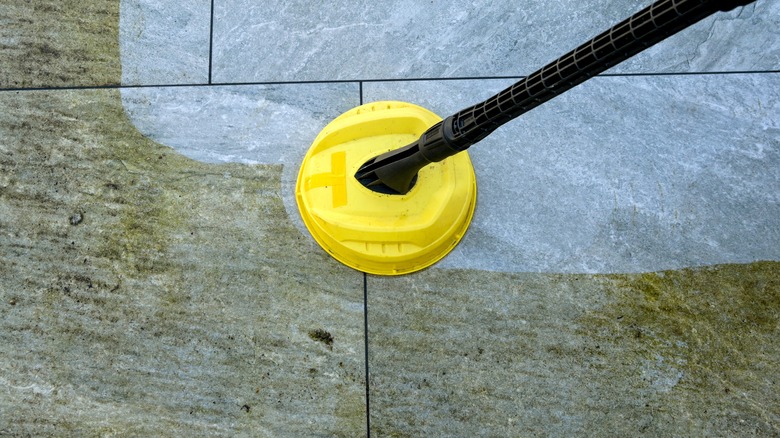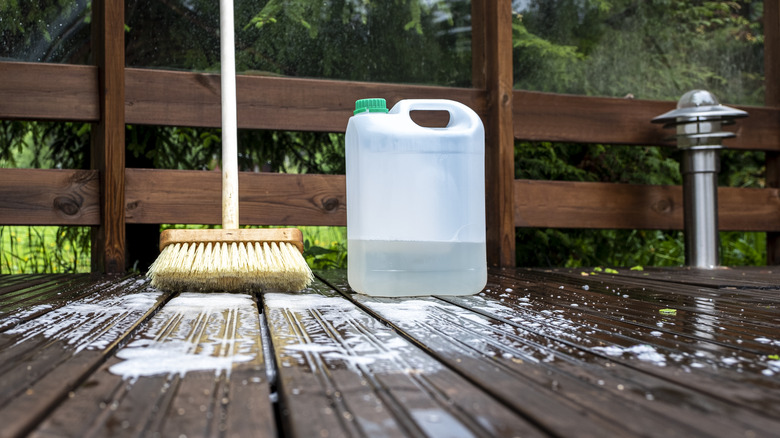Remove Gross Mold From Your Patio With A Simple Household Staple
We may receive a commission on purchases made from links.
Patios are one of the best ways to add value to your home and create an outdoor living space, and they don't require any complicated stilt systems like balconies and decks. Patios sit at (or just about) level with your home's main floor, which is fantastic for convenience's sake. But it also means that whenever it rains, the air is humid, or you have some weeds crop up between pavers, your patio becomes susceptible to mold. On brick or stone pavers, wood, and even concrete, mold can appear as tiny black and brown dots at first, growing darker, fuzzier, more slimy, and larger over time.
On its face, this might seem like no big deal. Sure, it's a little icky, but it's outdoors, at least, right? Unfortunately, if left untreated, mold can spread and cause serious structural damage to your patio. Worse still, it can even find its way onto the walls and foundation of your house. This can all make for costly renovation projects, so treating it ASAP is critical. But don't hop over to the home improvement store to buy an expensive, single-purpose product for patio mold. Instead, look at your laundry supply cabinet and take out the oxygenated bleach. Oxygen bleach is strong enough to kill the mold and safe to use on many surfaces. It can make your patio look mold-free and new again.
How to use oxygenated bleach on the patio
You only need two key things to use this tip: oxygen bleach and water. You already have the oxygen bleach if you have a canister of Oxi-Clean (found on Amazon) or other oxygen-brightening laundry powder. If not, you can easily purchase it from a local home and garden or grocery store. The water both dilutes the oxygen bleach, allowing a little product to go a long way and activates the cleaning agents in the oxygen bleach. Mix 1 tablespoon of oxygen bleach with every 1 cup of water for an effective ratio for patio cleaning.
To apply this solution, add it to a spray bottle and thoroughly spritz down the areas with signs of mold and mildew — learn how to tell the difference between mold and mildew in our conversation with an expert. Allow the solution a few minutes to sink and time to actually kill off any spores. Then, you can use a scrub brush or sponge to work on the product further. You should be able to see an immediate difference straight away — if the mold is already well-established, you may need to reapply or further spot-treat some areas. Finally, rinse the area down with clean water. Be sure to do this on a warm, sunny day so the patio can dry out thoroughly. Otherwise, you may as well just ask the mold to grow back again.
Why oxygenated bleach works against mold
Oxygenated bleach is often used as an alternative to chlorine bleach, as it is able to lift stains, clean, and disinfect very well. It is typically made up of sodium percarbonate, which is a combination of soda ash and hydrogen peroxide. Soda ash is naturally occurring, although it now exists in synthetic forms as well, and this substance has been used as a cleaner since the days of ancient Egypt. At the same time, hydrogen peroxide is a beloved multi-purpose stain fighter. Combined to make sodium percarbonate, this duo is nearly unstoppable at cleaning and stain lifting.
Not only is it powerful enough to kill mold on your patio, but it's also safe to use outdoors as an eco-friendly cleaner. Oxygen bleach is biodegradable and doesn't harm vegetation, so you don't have to worry about it damaging your lawn, patio plants, or nearby garden beds. That's why oxygen bleach is a must-have when it comes to removing mold both inside and outside the home. Diluted oxygen bleach is safe to use on many surfaces, such as wood, concrete, brick, and tile, but be sure to spot-check that it's compatible with your patio materials before tackling any project.


